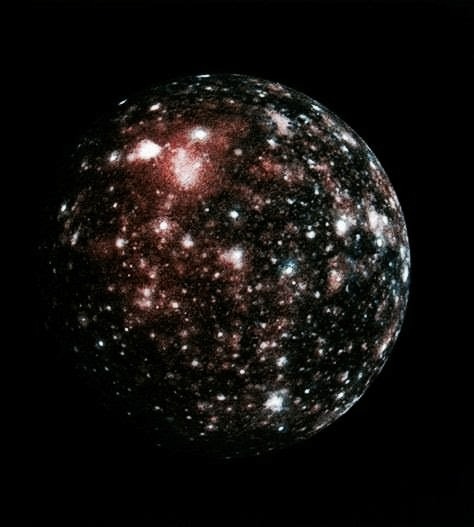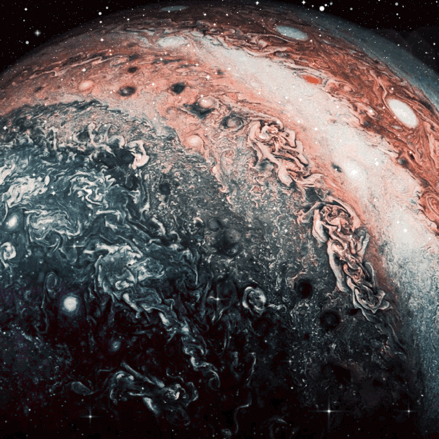Jupiter In Infrared, Shoemaker–Levy 9 Collision (left), Io (right)

Jupiter in infrared, Shoemaker–Levy 9 collision (left), Io (right)
Comet Shoemaker–Levy 9 was a comet that broke apart in July 1992 and collided with Jupiter in July 1994, providing the first direct observation of an extraterrestrial collision of Solar System objects. This generated a large amount of coverage in the popular media, and the comet was closely observed by astronomers worldwide. The collision provided new information about Jupiter and highlighted its possible role in reducing space debris in the inner Solar System.
source
More Posts from Jovian-witch and Others

Io transiting Jupiter, photographed by Voyager 1, 31 January 1979. South is up, which is why the Great Red Spot’s in the upper hemisphere.
(As with yesterday’s gif, I’m not fully certain I’ve identified the moon correctly: it looks like Io to me, and the orbital speed seems about right, but for the life of me I can’t get HORIZONS to agree with the pictures: at the time of the first frame (C1541036), my spreadsheet tells me that none of the Galilean moons should even be in the frame. The problem’s fixed if I pretend that the z-coordinate of every position is zero, but that’s cheating….)
main: @a-exsists




Made for a Jupiter planetary working I'm planning. 🌈⚡
Incoming! We’ve Got Science from Jupiter!
Our Juno spacecraft has just released some exciting new science from its first close flyby of Jupiter!

In case you don’t know, the Juno spacecraft entered orbit around the gas giant on July 4, 2016…about a year ago. Since then, it has been collecting data and images from this unique vantage point.

Juno is in a polar orbit around Jupiter, which means that the majority of each orbit is spent well away from the gas giant. But once every 53 days its trajectory approaches Jupiter from above its north pole, where it begins a close two-hour transit flying north to south with its eight science instruments collecting data and its JunoCam camera snapping pictures.

Space Fact: The download of six megabytes of data collected during the two-hour transit can take one-and-a-half days!

Juno and her cloud-piercing science instruments are helping us get a better understanding of the processes happening on Jupiter. These new results portray the planet as a complex, gigantic, turbulent world that we still need to study and unravel its mysteries.
So what did this first science flyby tell us? Let’s break it down…
1. Tumultuous Cyclones

Juno’s imager, JunoCam, has showed us that both of Jupiter’s poles are covered in tumultuous cyclones and anticyclone storms, densely clustered and rubbing together. Some of these storms as large as Earth!

These storms are still puzzling. We’re still not exactly sure how they formed or how they interact with each other. Future close flybys will help us better understand these mysterious cyclones.

Seen above, waves of clouds (at 37.8 degrees latitude) dominate this three-dimensional Jovian cloudscape. JunoCam obtained this enhanced-color picture on May 19, 2017, at 5:50 UTC from an altitude of 5,500 miles (8,900 kilometers). Details as small as 4 miles (6 kilometers) across can be identified in this image.

An even closer view of the same image shows small bright high clouds that are about 16 miles (25 kilometers) across and in some areas appear to form “squall lines” (a narrow band of high winds and storms associated with a cold front). On Jupiter, clouds this high are almost certainly comprised of water and/or ammonia ice.
2. Jupiter’s Atmosphere
Juno’s Microwave Radiometer is an instrument that samples the thermal microwave radiation from Jupiter’s atmosphere from the tops of the ammonia clouds to deep within its atmosphere.

Data from this instrument suggest that the ammonia is quite variable and continues to increase as far down as we can see with MWR, which is a few hundred kilometers. In the cut-out image below, orange signifies high ammonia abundance and blue signifies low ammonia abundance. Jupiter appears to have a band around its equator high in ammonia abundance, with a column shown in orange.

Why does this ammonia matter? Well, ammonia is a good tracer of other relatively rare gases and fluids in the atmosphere…like water. Understanding the relative abundances of these materials helps us have a better idea of how and when Jupiter formed in the early solar system.
This instrument has also given us more information about Jupiter’s iconic belts and zones. Data suggest that the belt near Jupiter’s equator penetrates all the way down, while the belts and zones at other latitudes seem to evolve to other structures.
3. Stronger-Than-Expected Magnetic Field

Prior to Juno, it was known that Jupiter had the most intense magnetic field in the solar system…but measurements from Juno’s magnetometer investigation (MAG) indicate that the gas giant’s magnetic field is even stronger than models expected, and more irregular in shape.

At 7.766 Gauss, it is about 10 times stronger than the strongest magnetic field found on Earth! What is Gauss? Magnetic field strengths are measured in units called Gauss or Teslas. A magnetic field with a strength of 10,000 Gauss also has a strength of 1 Tesla.

Juno is giving us a unique view of the magnetic field close to Jupiter that we’ve never had before. For example, data from the spacecraft (displayed in the graphic above) suggests that the planet’s magnetic field is “lumpy”, meaning its stronger in some places and weaker in others. This uneven distribution suggests that the field might be generated by dynamo action (where the motion of electrically conducting fluid creates a self-sustaining magnetic field) closer to the surface, above the layer of metallic hydrogen. Juno’s orbital track is illustrated with the black curve.
4. Sounds of Jupiter
Juno also observed plasma wave signals from Jupiter’s ionosphere. This movie shows results from Juno’s radio wave detector that were recorded while it passed close to Jupiter. Waves in the plasma (the charged gas) in the upper atmosphere of Jupiter have different frequencies that depend on the types of ions present, and their densities.
Mapping out these ions in the jovian system helps us understand how the upper atmosphere works including the aurora. Beyond the visual representation of the data, the data have been made into sounds where the frequencies and playback speed have been shifted to be audible to human ears.
5. Jovian “Southern Lights”

The complexity and richness of Jupiter’s “southern lights” (also known as auroras) are on display in this animation of false-color maps from our Juno spacecraft. Auroras result when energetic electrons from the magnetosphere crash into the molecular hydrogen in the Jovian upper atmosphere. The data for this animation were obtained by Juno’s Ultraviolet Spectrograph.

During Juno’s next flyby on July 11, the spacecraft will fly directly over one of the most iconic features in the entire solar system – one that every school kid knows – Jupiter’s Great Red Spot! If anybody is going to get to the bottom of what is going on below those mammoth swirling crimson cloud tops, it’s Juno.

Stay updated on all things Juno and Jupiter by following along on social media: Twitter | Facebook | YouTube | Tumblr
Learn more about the Juno spacecraft and its mission at Jupiter HERE.
Jupiterʼs moons




Ganymede, Callisto, Io and Europa





CGI renderings of Jupiter, ‘King of the Planets’
The largest planet in the Solar System, likely the first planet to form after the Sun did, continues to dominate over the System with its almost 80 moons and immensely steep and influential gravity well.
Keep reading
Uncommon Correspondences: Jupiter 🌼

🌼 Abundance | amplification | exaggeration | expansion | “larger than…”
🌼 Affluence | benefactors | charity
🌼 Judgment | Attorneys and lawyers | courts | church officials | religion
🌼 Philosophy | professional people | professors and one’s education
🌼 Books | publishing
🌼 Celebrations | ceremonies | joviality | luck | optimism | prosperity
🌼 Fat metabolism | weight | arteries




Jupiter ✨ gifs made by me :)






jupiter.
-
 javi07mx reblogged this · 1 month ago
javi07mx reblogged this · 1 month ago -
 femmehepbvrn reblogged this · 3 months ago
femmehepbvrn reblogged this · 3 months ago -
 hieroglifosensivel liked this · 5 months ago
hieroglifosensivel liked this · 5 months ago -
 natural-primal-instinct-5 liked this · 7 months ago
natural-primal-instinct-5 liked this · 7 months ago -
 seanoweevil liked this · 7 months ago
seanoweevil liked this · 7 months ago -
 wanderer001 reblogged this · 7 months ago
wanderer001 reblogged this · 7 months ago -
 wanderer001 liked this · 7 months ago
wanderer001 liked this · 7 months ago -
 shannybangbang reblogged this · 7 months ago
shannybangbang reblogged this · 7 months ago -
 dmabs liked this · 1 year ago
dmabs liked this · 1 year ago -
 mikaeloliveira96 liked this · 3 years ago
mikaeloliveira96 liked this · 3 years ago -
 uvadulce liked this · 4 years ago
uvadulce liked this · 4 years ago -
 may2217 liked this · 4 years ago
may2217 liked this · 4 years ago -
 hiddlecondas liked this · 4 years ago
hiddlecondas liked this · 4 years ago -
 dead-or-alive reblogged this · 4 years ago
dead-or-alive reblogged this · 4 years ago -
 stravanzer liked this · 4 years ago
stravanzer liked this · 4 years ago -
 veeshadirus liked this · 4 years ago
veeshadirus liked this · 4 years ago -
 starlightkay liked this · 4 years ago
starlightkay liked this · 4 years ago -
 dead-or-alive liked this · 4 years ago
dead-or-alive liked this · 4 years ago -
 space-up-my-sleeve reblogged this · 4 years ago
space-up-my-sleeve reblogged this · 4 years ago -
 mikai-yah-777 reblogged this · 4 years ago
mikai-yah-777 reblogged this · 4 years ago -
 yahveh-el-olam liked this · 4 years ago
yahveh-el-olam liked this · 4 years ago -
 jovian-witch reblogged this · 4 years ago
jovian-witch reblogged this · 4 years ago -
 a-exists liked this · 4 years ago
a-exists liked this · 4 years ago -
 lunedark liked this · 4 years ago
lunedark liked this · 4 years ago -
 number-memory liked this · 4 years ago
number-memory liked this · 4 years ago -
 thirtysixgnomes reblogged this · 4 years ago
thirtysixgnomes reblogged this · 4 years ago -
 mutant-alien-rebloggos reblogged this · 4 years ago
mutant-alien-rebloggos reblogged this · 4 years ago -
 roskiskissa liked this · 4 years ago
roskiskissa liked this · 4 years ago -
 rabbitsinthemeadow liked this · 4 years ago
rabbitsinthemeadow liked this · 4 years ago -
 midwest-fannibal reblogged this · 4 years ago
midwest-fannibal reblogged this · 4 years ago -
 midwest-fannibal liked this · 4 years ago
midwest-fannibal liked this · 4 years ago -
 solascientia liked this · 4 years ago
solascientia liked this · 4 years ago -
 off-to-rivendell liked this · 4 years ago
off-to-rivendell liked this · 4 years ago -
 cubedcoffeecake liked this · 4 years ago
cubedcoffeecake liked this · 4 years ago -
 alpacaslovetheoffice liked this · 4 years ago
alpacaslovetheoffice liked this · 4 years ago -
 onewhositswiththeturtles reblogged this · 4 years ago
onewhositswiththeturtles reblogged this · 4 years ago -
 pendraegon reblogged this · 4 years ago
pendraegon reblogged this · 4 years ago -
 astra-peraspera reblogged this · 4 years ago
astra-peraspera reblogged this · 4 years ago -
 ishiganto liked this · 4 years ago
ishiganto liked this · 4 years ago -
 darthlenaplant reblogged this · 4 years ago
darthlenaplant reblogged this · 4 years ago -
 darthlenaplant liked this · 4 years ago
darthlenaplant liked this · 4 years ago -
 explicitorder reblogged this · 4 years ago
explicitorder reblogged this · 4 years ago -
 thepeopleater liked this · 4 years ago
thepeopleater liked this · 4 years ago -
 sparklemiranda liked this · 4 years ago
sparklemiranda liked this · 4 years ago

blog dedicated to my work with the planet Jupiter
96 posts